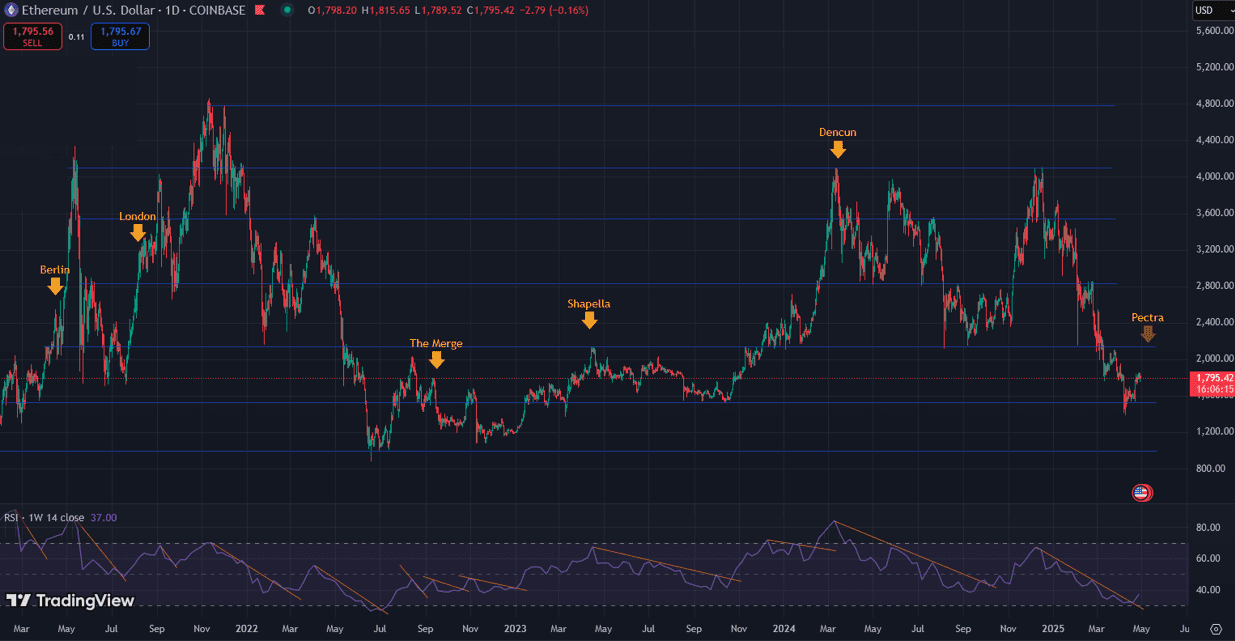Ethereum is preparing for its Pectra upgrade, a significant network enhancement scheduled for next week. This upgrade aims to address key challenges and improve the overall Ethereum ecosystem. But what exactly is Pectra, and how might it affect the price of Ether (ETH)?
What is the Ethereum Pectra Upgrade?
The Pectra upgrade is a set of improvements designed to enhance Ethereum’s scalability, user experience (UX), and staking efficiency. It includes 11 Ethereum Improvement Proposals (EIPs) that seek to make the network more competitive and attractive to users and developers.
Key Upgrades in Pectra:
- EIP-7702: Allows user wallets to temporarily act like smart contracts, enabling fee sponsorship and gas payments in tokens other than ETH.
- EIPs 7251, 6110, and 7002: Simplify validator onboarding and exits and allow validators to hold up to 2,048 ETH instead of 32.
How Pectra Improves User Experience:
One of the primary goals of Pectra is to make Ethereum more user-friendly. EIP-7702, in particular, addresses this by allowing users to pay gas fees with tokens other than ETH. This could lower entry barriers for new users and enable decentralized applications (DApps) to sponsor gas fees, improving wallet functionality.
These changes are especially beneficial for onboarding non-technical users in sectors like gaming, payments, and mobile apps, which often face hurdles due to poor UX.
Enhanced Staking Efficiency:
Pectra also introduces improvements to the staking process. EIPs 7251, 6110, and 7002 make it easier for validators to join and exit the network, and validators can now stake up to 2,048 ETH instead of the previous limit of 32 ETH. These changes are expected to attract more institutional validators to the Ethereum network.
These improvements are very timely, as some institutions have started selling their ETH holdings. Pectra may stimulate renewed engagement from big players.
Potential Impact on ETH Price:
The Pectra upgrade is designed to influence both the demand and supply of ETH. By improving user experience and streamlining staking, Pectra aims to increase demand and reduce the available supply of ETH, which could drive its price upward.
- Demand: Improved UX could attract mainstream users and developers, increasing onchain activity.
- Supply: Streamlined staking may lead to more ETH being locked in validator nodes, tightening the circulating supply.
Furthermore, increased transaction throughput could also accelerate ETH burning, reducing the supply even further. Currently, Ethereum is experiencing one of its lowest burning periods ever, burning only around 70 ETH per day, compared to 2,000 to 4,000 ETH in 2024. A resurgence in activity could push the burn rate higher, adding deflationary pressure that may support the price.

Will Pectra Reverse the ETH Price Downtrend?
While the full impact of Pectra may take time to materialize, the upgrade could provide the narrative Ether needs to regain market momentum. Technically, ETH appears to have already formed a local bottom, with the weekly RSI breaking out of its downtrend on April 20. This could signal the end of a correction that wiped out as much as 66% of ETH’s value since December 2024.

Historically, Ethereum upgrades have often coincided with short-lived price spikes. However, the current market cycle is similar to 2021, when upgrades like Berlin and London helped fuel a major bull run. If history repeats itself, Pectra could sync with the broader rally and mark Ethereum’s return to strength.
Looking Ahead: The Fusaka Upgrade
The Fusaka hard fork, scheduled for late 2025, could add further upside potential to Ether. This continuous improvement of the Ethereum network is crucial for its long-term success and adoption.
In Conclusion:
Ethereum’s Pectra upgrade is a multi-faceted enhancement designed to improve user experience, staking efficiency, and overall network scalability. While its full impact on ETH price remains to be seen, the upgrade has the potential to attract more users and developers, drive up demand, and ultimately, contribute to a positive price trend.